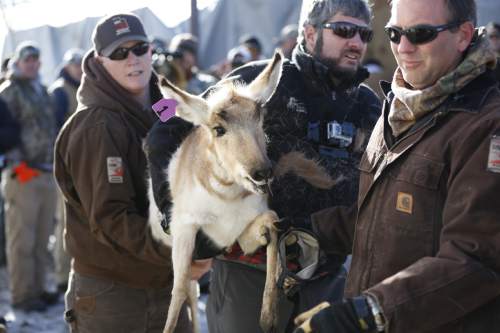This is an archived article that was published on sltrib.com in 2014, and information in the article may be outdated. It is provided only for personal research purposes and may not be reprinted.
Parker Mountain, Wayne County • Perhaps the jackalope really does exist.
Rumored to be a mix between a jackrabbit and a deer or an antelope, the mythical western creature is rarely spotted in the wild, but often found in curio shops and small town bars.
Some think the Parker Mountain pronghorn have jackalope tendencies. They're prolific, to say the least.
More than 5,000 of the ungulates have been caught on the mountain and moved to other locations in Utah and throughout the west since the mid-1970s.
There apparently are plenty more where they came from.
"We must have given them some kind of a hormone," said Abe Johnson, a retired conservation officer with the Utah Division of Wildlife Resources (DWR). "I don't know what that hormone was, but it was good."
Johnson was there when 20 pronghorn from Montana were released on Parker Mountain in 1964. Another 109 were released in 1965.
Ten years later, wildlife managers already were moving them to other locations to cut the growing herd.
State wildlife biologists have set a population goal of 1,500 animals for the Parker Mountain pronghorn herd. An estimated 2,300 were in the area before this December's roundup.
Collecting pronghorn is a combination of high and low tech.
With help from helicopter pilots, groups of pronghorn are chased to a 300-foot runway. The 35-foot-wide corridor is lined with stretchy netting so when pronghorn jump into it in an attempt to escape, they bounce back. The pronghorn eventually end up in a large, round corral. Screens are pulled up on the sides to calm the animals down.
When the pronghorn have settled and cooled down, they are released in smaller groups. People — appropriately called muggers — catch the animals by hand and then hold them so biologists can put on ear tags and radio collars.
Blood and fecal samples also are collected to test for disease.
Wildlife managers launch a pronghorn roundup in years when the population needs to be culled. Every year from 2005 to 2009, the ungulates were gathered up and moved. But the roundup went on hiatus for five years until 2014.
This year was the first time the state wildlife agency ran two traps and two helicopters at the same time. And more than 150 people showed up to work on the capture — many of them volunteers from communities around Parker Mountain in south-central Utah, wildlife conservation groups and college students. U.S. Forest Service and Bureau of Land Management personnel also helped.
Wildlife managers had hoped to gather 300 to 350 animals this year. But one of the two helicopters hired to round up the pronghorn had a hard landing and was put out of commission early the first day.
In all, 236 pronghorn were caught over two days earlier this month. The animals were released at four other sites, including one west of Utah Lake and another in the northeastern corner of the state.
Teresa Griffin, wildlife resource's southern region wildlife manager, said the Parker Mountain area has the highest birth rate in the state. On average, 75 fawns are born for every 100 does annually.
"We see a lot of fawns and sometimes even triplets," Griffin said. "The production is so good that it is hard to keep the population at the objective through hunting alone. We use the transplants to try and help keep us at 1,500 animals."
Biologists believe the mountain's high elevation, more moisture than other herds typically see and great forage perpetuate the Utah pronghorn herd's baby boom.
More recent efforts to help wildlife also are giving the population a boost, according to Terry Messmer, director at Utah State University's Jack H. Berryman Institute. The school has not studied Parker Mountain pronghorn specifically, but has done extensive work studying sage grouse in the area.
"Things we have done for sage grouse have also benefited pronghorn," Messmer said. "We've really opened up the canopy and grown more 'groceries'."
Ranchers' water infrastructure also probably has helped the pronghorn. And predator control hasn't hurt.
Johnson agrees all those factors may be responsible for the healthy herd. But he has another theory.
"This is God's country. That is why they do so well here," Johnson said. "They are happy. If mama is happy and the mama antelope are happy, they are all happy."
Twitter: @BrettPrettyman



